Stroll through Kew Gardens
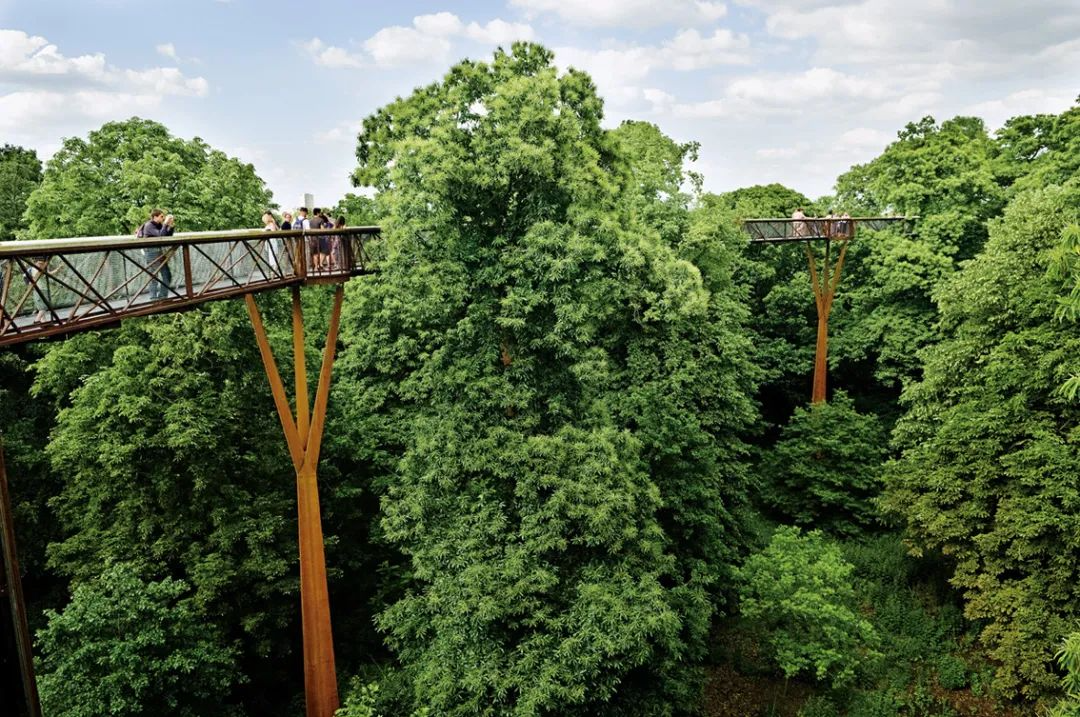
■ Kew Gardens opened a treetop skywalk in 2008. This skywalk is 18 meters above the ground. Visitors can not only get close to birds in nature, but also overlook the beautiful scenery of Kew Gardens.
Stroll through Kew Gardens
Written by Chen Jinyong
The Royal Botanic Gardens, Kew, is one of the most famous botanical gardens in the world. It not only has a long history, ancient buildings, and beautiful environment, but also has the richest collection of plants in the world. Walking through it, touching the vicissitudes of historical relics, and appreciating the beauty of flowers and trees, one can't help but admire the vitality of this ancient Royal Botanic Garden today.
Royal blood
Since its establishment in 1759, Kew Gardens, a world-renowned botanical garden, has gone through more than two centuries. Today, Kew Gardens not only has a natural garden covering an area of about 1.32 square kilometers, but also has the world's largest and most classified plant collection, with millions of tourists visiting and playing here every year. In addition, Kew Gardens, with its long history and beautiful scenery, was selected as a World Heritage Site by UNESCO in 2003. One of the reasons is probably that this botanical garden, which is still full of vitality, has the ancient royal "blood" flowing through it.
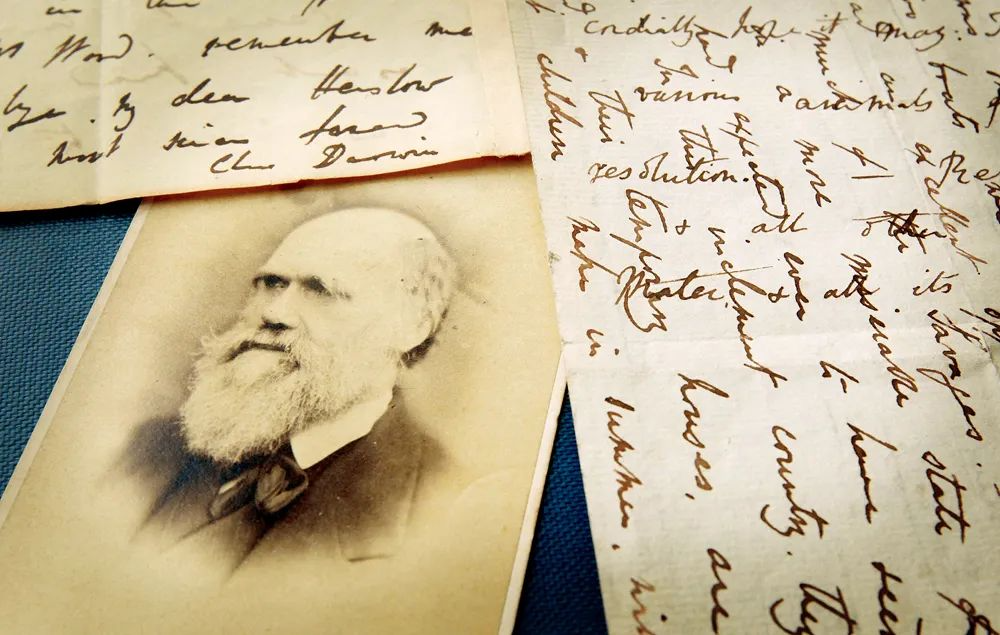
■ Darwin's handwritten letter displayed in the Kew Gardens Herbarium. This letter was written by Darwin to his mentor John Henslowe in April 1833. In addition to these letters, Kew Gardens also preserves a number of fossils and plant specimens that Darwin collected from all over the world during his lifetime.
In 1731, Frederick, Prince of Wales, son of George II, purchased the estate where Kew Gardens is now located. In 1736, Prince Frederick married Princess Augusta, and they both happened to be avid gardeners. The pursuit of English gardening prompted them to continuously expand their gardens. After Prince Frederick died in 1751, Princess Augusta still did not give up her love for gardening. With the support of Earl of Bute, who later became the British Prime Minister, the idea of "building a garden that includes plants from all over the world" was put on the agenda. In 1759, Princess Augusta established the prototype of Kew Gardens on the south bank of the Thames in London at the suggestion of William Ayton - a 3.5-hectare garden, of which 2.5 hectares were arboretums and the rest were herb gardens. In order to enrich the plant species, a large greenhouse and citrus greenhouse with a length of 35 meters and a height of 6 meters were built in the garden. By 1768, 3,400 species of plants had been collected. These plants are not only highly ornamental, but many of them also have important scientific research value. After Princess Augusta's death, her son George III inherited the estate of Kew Gardens in 1772 and merged it with her estate in Richmond. On the advice of Joseph Banks, he continued to introduce various plants, especially those with commercial value such as coffee, tobacco, tea, and breadfruit.
In 1841, Queen Victoria, the granddaughter of George III, handed over the royal estate to the British government. It was officially named the Royal Botanic Gardens, Kew, and began to open to the public. In 1844, Queen Victoria lived for the last time in Kew Palace, a Dutch-style building built in 1631. This oldest property in Kew was also opened to the public in 1898. In 1897, on the 60th anniversary of her accession to the throne, Queen Victoria donated Charlotte House, the last royal property in Kew. Not only that, during Queen Victoria's reign, many Kew Gardens staff were awarded the Victorian Medal of Honor, which shows the Queen's recognition and appreciation of Kew Gardens.
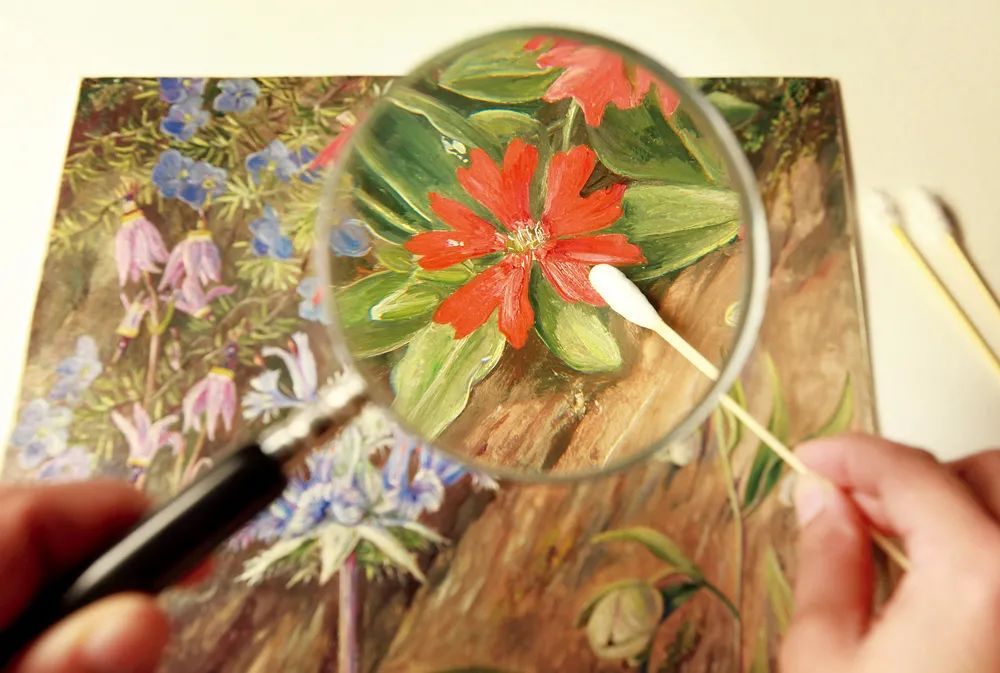
■ Staff are carefully cleaning Marianna North's paintings with cotton swabs. Marianna North was a famous British botanical illustrator in the 18th century. Her 833 paintings are all preserved in the newly renovated Marianna North Gallery in Kew Gardens.
Although Kew Gardens has gradually lost its sense of mystery as a royal garden, it has also gained greater room for development and played a greater role in reality. After taking office, the first director, William Hook, attached great importance to the collection, development and utilization of economic plants. The cinchona tree, whose bark contains the medicinal ingredient quinine, was collected from the Andes Mountains in South America and was later introduced to Sikkim and India to treat tropical malaria, benefiting the local people. Rubber trees in Malaysia were also successfully cultivated through the efforts of Kew Gardens.
In addition, William Hook also attached great importance to communication with the public. Kew Gardens not only began to open to the public on non-holidays, but also published an official Kew Gardens tour brochure to facilitate public visits. This tradition of serving the public has continued to this day. In 1988, Gillian Plans, who took office as director, also founded the "Friends of Kew Gardens" club, which widely recruited members and disclosed more information to allow the public to have a more comprehensive and in-depth understanding of Kew Gardens.
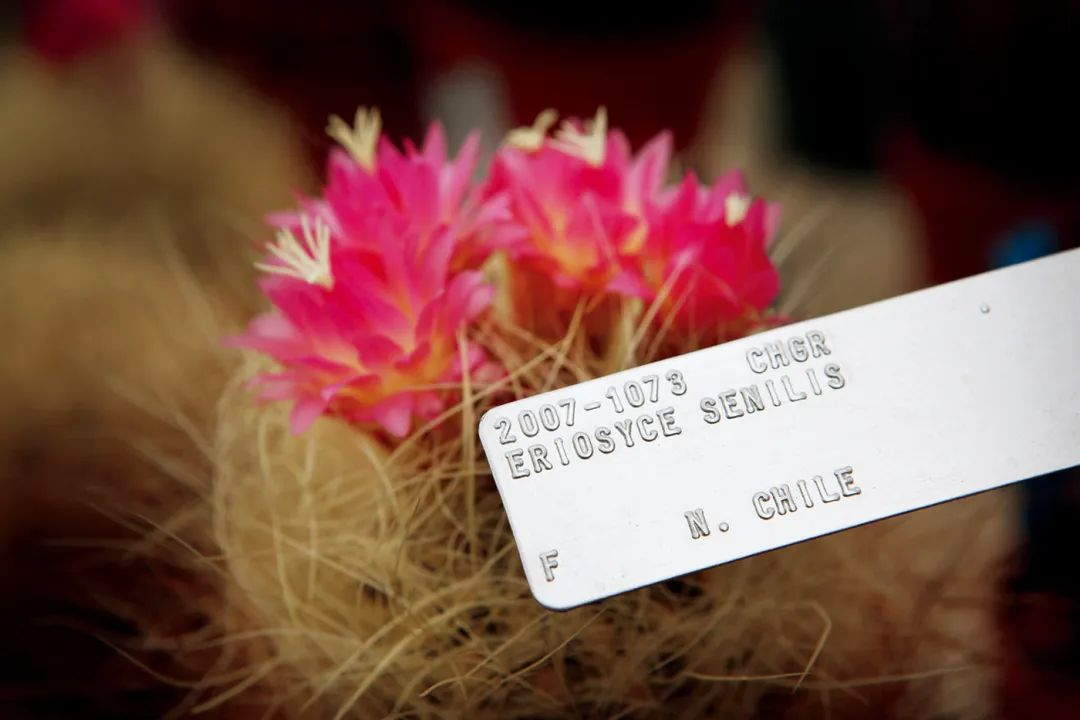
■ Kew Gardens has about 19,000 species of plants, each with its own “identity tag.” The picture shows a flowering Aurora cactus from Chile.
Time Corridor
In the ancient Royal Botanical Gardens of Kew, you can appreciate the simplicity and elegance of royal architecture, as well as the power and beauty brought by technological progress. The greenhouse buildings of different ages and styles are like a time corridor that runs through ancient and modern times, housing exotic flowers and plants from all over the world.
Kew Palace, built in 1631, is the oldest building in Kew Gardens. It has been the summer residence of the royal family since the early 18th century. The three-story red brick tile house is particularly eye-catching. The back garden is in a typical European neat style, with a pool, sculptures and water features, neatly trimmed hedges, and a variety of edible, medicinal and fragrant plants. Charlotte Villa is another royal summer residence in Kew Gardens. It was built in the 1770s. Unlike the luxurious style of Kew Palace, the villa has only two floors, with rough brick walls, straw roofs, red brick floors, and marble fireplaces. It is very simple. The villa is hidden in the forest of birch and rhododendron, which makes it more quiet.
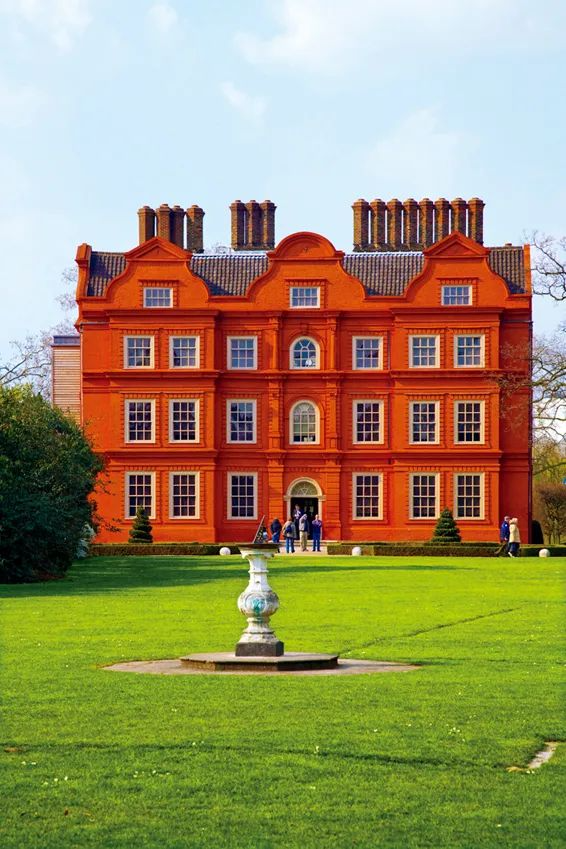
■ Kew Palace, built in 1631, is the oldest building in Kew Gardens. Although the building was opened to the public as early as 1898, members of the British royal family still favor it. The 80th birthday party of the current Queen Elizabeth II of the United Kingdom was held here.
The most famous building in Kew Gardens is the Palm House built in the Victorian era. This large, curved greenhouse made of cast iron has smooth lines and is composed of 16,000 curved tempered glass pieces. It is 20 meters high and covers an area of 2,248 square meters. Despite opposition from the director of the horticultural department, the designer at the time strongly requested that it be built next to the pond in order to have a beautiful reflection in the water. In pursuit of visual effects, the foundation of the entire greenhouse was raised by 1 meter, the boiler was placed in the basement, the chimney was erected 150 meters away on the other side of the pond, and the coal was transported through an underground passage. The Palm House is surrounded by hedges, wide lawns, seasonal flower beds and colorful rose gardens, making the greenhouse building complement the surrounding environment and become a must-see for tourists. In the first 10 months of the Palm House's opening, Queen Victoria visited the Palm House three times and praised its charm.
The Palm Conservatory mainly cultivates the "Queen of the Plant World" - palm plants. Here people can see tropical palm plants from all over the world. The rarest one is the sea coconut, which is only found in the Seychelles Islands. Its seeds are the largest in the plant world, weighing up to 18 kilograms. Cycads are also the focus of the Palm Conservatory. Now Kew Gardens has collected all the genera of cycads. The most precious one is the heart bread cycad, which is one of the oldest potted plants in the world and has a history of more than 200 years. The rarest one is the Wood Cycad. Kew Gardens collected a male plant in 1895. Due to the lack of female plants, it cannot reproduce. This tree, which has become extinct in the wild, may become the loneliest tree.
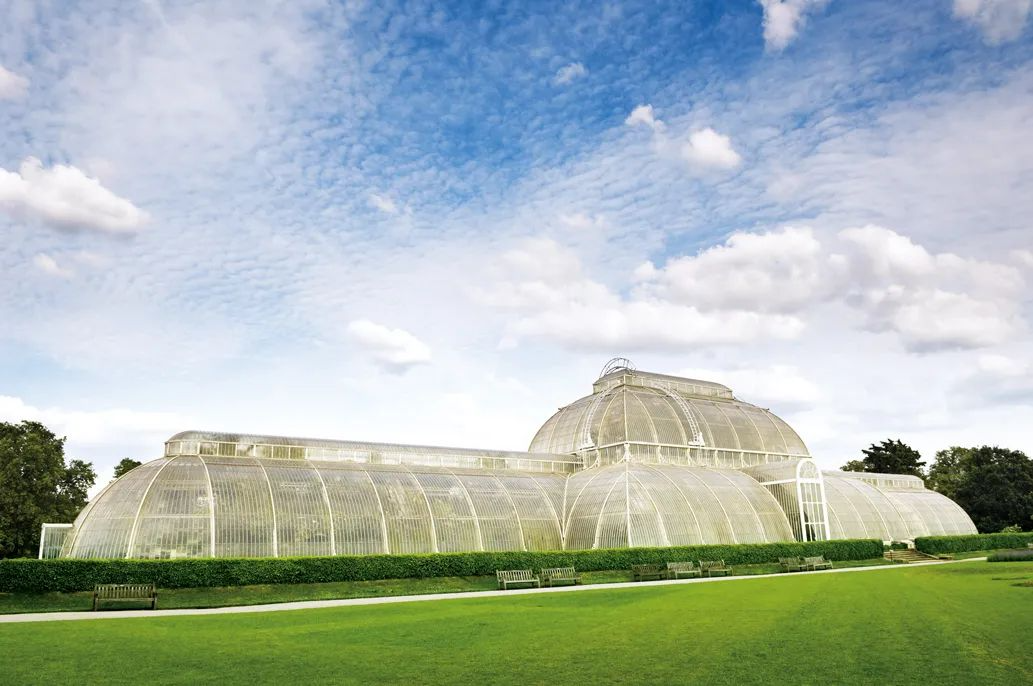
■ The Victorian-era Palm Conservatory is one of Kew Gardens’ iconic buildings.
The Temperate Greenhouse is the largest greenhouse in Kew Gardens, 180 meters long, 42 meters wide and 19 meters high. It was built in 1899. The Temperate Greenhouse is used to cultivate and display subtropical plants from all over the world. The tallest one is the Chilean raffia, which was introduced and cultivated in 1846. It is now 17 meters high and weighs 54 tons. It will soon grow to the roof. Then people will regretfully see it having to be sawed off after more than 100 years of vicissitudes.
The Princess of Wales Conservatory is the most modern large greenhouse. It was built and opened in 1987. Princess Diana cut the ribbon for it. The entire greenhouse covers an area of 4,490 square meters and consists of 10 independently controllable climate zones. Here you can see humid tropical rainforests and arid tropical desert landscapes, rare plants such as orchids, ferns and carnivorous plants, and different flower exhibitions. The most famous plant in the greenhouse is the giant arum. Its tubers are huge, up to 30 kilograms; its inflorescence is large and can grow up to 2 meters high; its flowers have a pungent smell to attract flies for pollination; it is very difficult to bloom. Kew Gardens has only bloomed five times in more than 100 years from 1889 to 1996, so every time it blooms, it causes a sensation in London. There is also a very rare Welwitschia orchid that grows in the Namibian desert. It absorbs the fog from the sea to replenish water. Its two slender and curved leaves can grow to several meters long. Victoria amazonica is a well-known plant. Its leaves can grow up to 2 meters in diameter and can bear the weight of a child. The flowers are white at first, then turn pink and red, and finally sink to the bottom of the water. The flowering period of a single flower lasts for 1 to 2 days. Lithops is also an interesting plant. It grows in the arid areas of South Africa. It looks like a stone. The base of its two fleshy leaves is buried in the stone soil, with only the upper part exposed. Light can pass through its upper transparent tissue to provide it with energy for photosynthesis. The flowers grow from the leaf gaps and are brightly colored to attract insects for pollination.
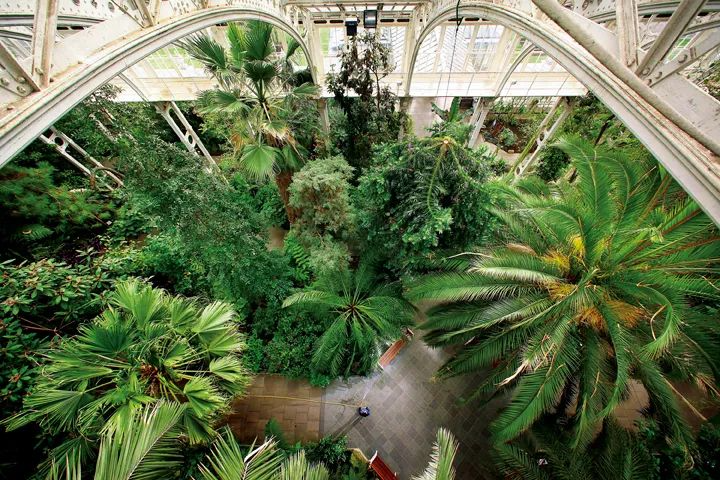
■ Interior view of the Temperate Greenhouse. Built in 1899, this greenhouse is currently the largest greenhouse in Kew Gardens and cultivates subtropical plants from all over the world.
The Evolution Hall behind the Temperate Greenhouse was built and opened in 1995. Through the arrangement of large rocks, living plants and bionic plants, it shows the main process of plant evolution over hundreds of millions of years. As soon as you step into the hall, you can see the fiery red magma in the cracks of the huge rocks emitting hot steam, and the magma under your feet is bubbling, symbolizing the birth of the earth. As the path winds, people can see the simulated fossils of bacteria and algae on the rocks and the mosses growing on the rocks, showing the birth of land plants 400 million years ago. Continuing forward, you can see various ferns, cycads and gymnosperms, showing the landscape of large plants 300 million years ago. Passing through the boulders, you can see a large number of modern angiosperms, representing the form of angiosperms when they appeared 100 million years ago. The whole process is accompanied by explanations, allowing people to understand the evolution of plants during the tour, combining education with entertainment.
The Millennium Seed Bank, newly built in 2000, is also a distinctive building in Kew Gardens. The studio is designed with a transparent glass curtain wall. Visitors can see through the glass the process of staff selecting, packaging and drying seeds, understand that the seeds can last nearly 200 years after being dried and sealed at low temperatures, and realize the importance of seed banks to the whole world, especially to Africa, where biodiversity has been sharply reduced due to severe desertification and over-collection.
The most modern building in Kew Gardens is the Davis Alpine Botanical Pavilion, which was built and opened in 2006. It has a unique design and appearance. It is only 16 meters long and 10 meters high. It is in the shape of a high arch. It can absorb cold air through the upper and lower openings and release hot air, providing a cool environment for the growth of alpine plants. At the same time, the air blown out by the fan hidden underground can also absorb heat and cool down during the rising process, so that the temperature in the pavilion is controlled below 32 degrees Celsius, which can greatly reduce the energy consumed by air conditioning and cooling. The greenhouse glass can transmit 90% of the light, meeting the requirements of alpine plants for light. At the same time, the fan-shaped shade net can also prevent the strong light from burning the plants in summer. The pavilion cultivates and displays various exotic alpine flowers, such as primroses, irises, saxifrages, pig bud flowers, Paris polyphylla, tulips, etc., which is refreshing.
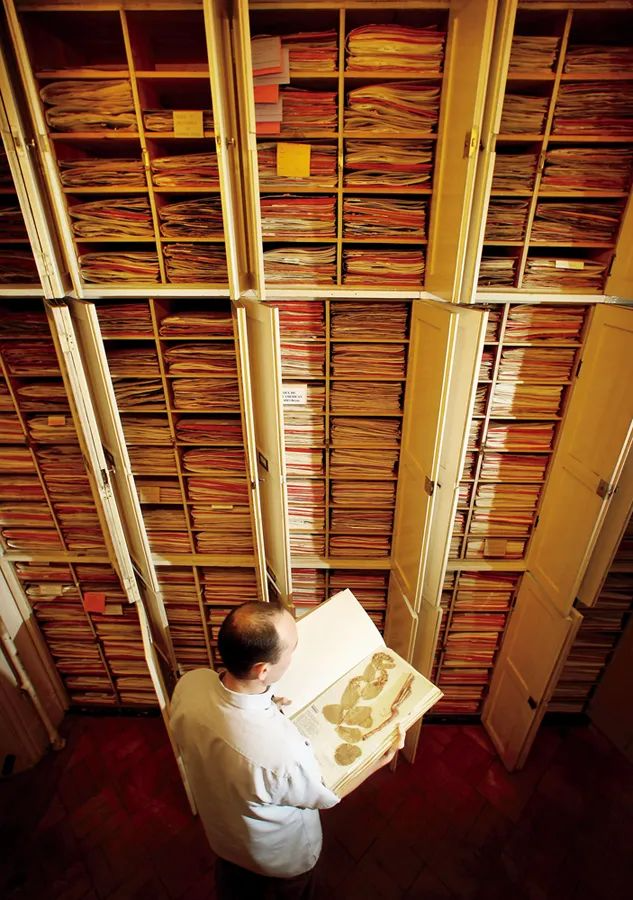
■ Ian Darbyshire, curator of the African Flora, is looking at a flattened plant specimen. Kew's herbarium houses about 7 million plant specimens, the oldest of which is more than 300 years old.
Four Seasons
As the world's most outstanding botanical garden, after more than 250 years of continuous collection, Kew Gardens has planted about 19,000 species of plants and collected about 7 million plant specimens; Kew Gardens' seed bank stores nearly 2 billion seeds of 30,000 wild plants from more than 140 countries; Kew Gardens' Economic Plant Museum has a collection of about 85,000 economic plants; Kew Gardens' Fungi Museum has a collection of 1.25 million fungus specimens. These amazing plant collections have established Kew Gardens' status as a world-class botanical garden, but Kew Gardens, once a royal garden, is probably more charming in its achievements in garden landscape.
Wandering in the vast arboretum, you can carefully browse the more than 5,000 trees in the park. The most worth seeing are of course the three oldest trees: Ginkgo, Sophora japonica and Robinia pseudoacacia, which were planted in the early days of the park and have a history of more than 200 years. Although the Ginkgo is still graceful, the Sophora japonica needs protection and support after experiencing too many vicissitudes. The North American redwood and giant sequoia are among the world's longest-lived and tallest tree species, native to the western United States, with thick bark and up to more than 100 meters in height, and are known as the "world's grandfather".
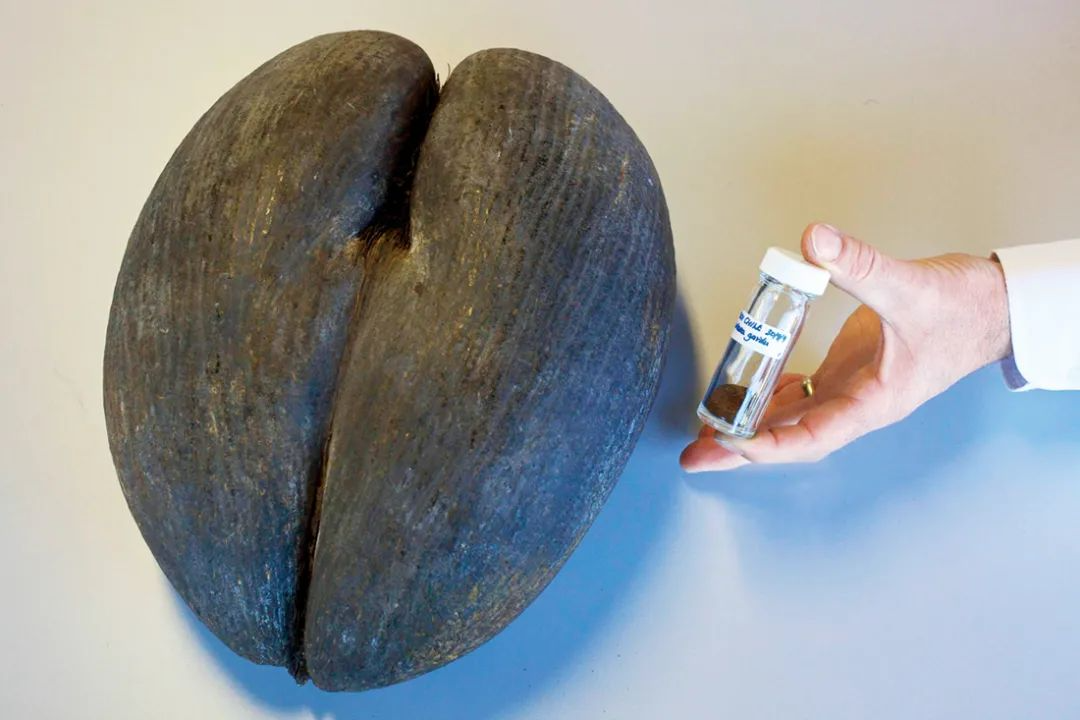
■ Seeds collected in the Millennium Seed Bank at Kew Gardens. The largest seed comes from the coco de mer, which is only found in the Seychelles Islands and weighs 18 kilograms. The smallest seed comes from an orchid in Chile, and this small container contains millions of seeds of this plant.
Specialty gardens mainly display plants with high ornamental value. For example, the Azalea Valley has undulating terrain and winding paths, and mainly cultivates and displays azaleas. Every May, azaleas of various colors bloom, and the red flowers and green leaves complement the lawn, creating a charming scene. The lilac garden is located on a wide lawn. When the lilac flowers bloom, the flowers are in full bloom, and the fragrance is so refreshing that it can intoxicate countless tourists. Roses are the national flower of the United Kingdom, and there are many varieties. The rose garden is located behind the palm greenhouse, and is arranged in a regular geometric pattern. Classical and modern rose varieties are cultivated. Not only are the flowers brightly colored and sweet, but the flowering period is also very long. It is a must-see attraction.
Places to appreciate herbaceous flowers include the Systematic Classification Garden, the Rock Garden, and the Kew Palace Back Garden. The Systematic Classification Garden planted more than 3,000 herbaceous plants from 51 families in 126 flower beds according to the evolutionary relationship of plants. It is one of the best places to learn about plant classification. The Rock Garden was built in 1882 and imitated the alpine landscape of the Pyrenees. Mountain plants from all over the world, such as delphinium, ivory ginseng, and mullein, are cultivated. The plants cultivated in the Kew Palace Back Garden are mainly economic plants, such as lavender, rosemary, sage, etc. When they bloom, the fragrance is fragrant and bees are flying, which is very pleasant.
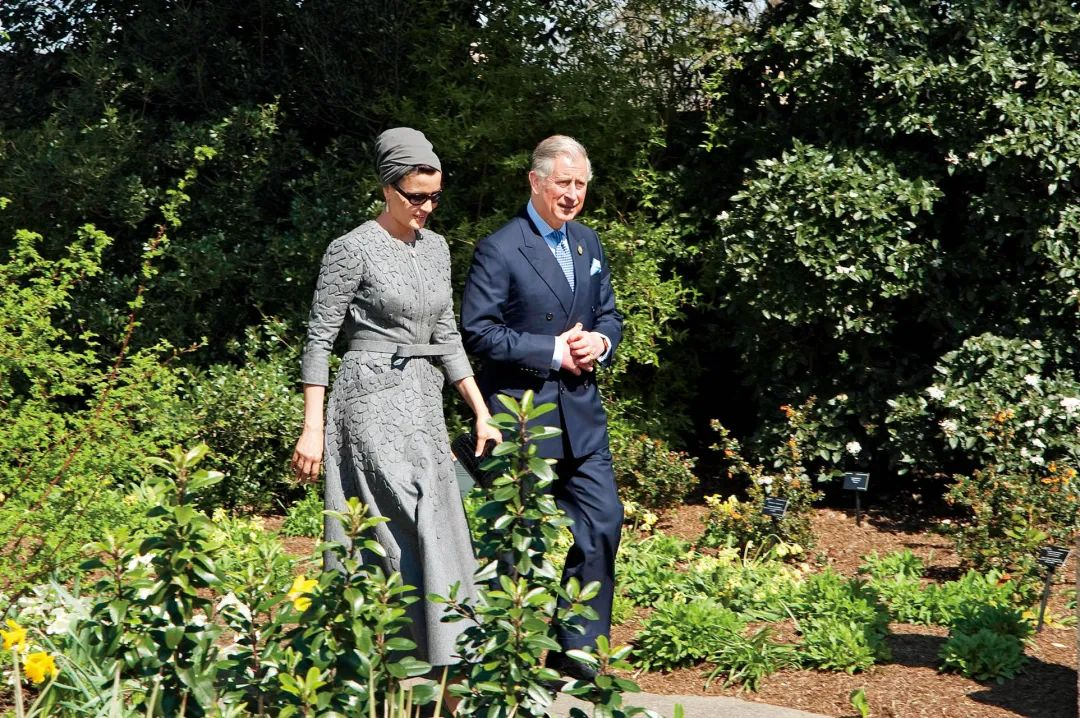
■ In April 2010, Prince Charles visited Kew Gardens with Qatari Princess Sheikha Mozah, who was invited to the event.
The Japanese Garden, covering an area of 5,000 square meters, is an exotic garden in Kew Gardens. The central wooden gate imitates the architectural style of Japan in the late 16th century, with intricately carved floral and animal patterns. The matching dry stone garden is a typical Japanese garden landscape of the same period, including the quiet garden with traditional stone paving, the animal garden with waterfalls as the main body, and the harmonious garden with rocks and plants. Common Japanese garden plants such as Japanese cypress, Japanese bamboo, Kurume azalea, cherry blossoms, etc. are planted, which is full of Japanese style.
These garden landscapes all have unique and charming scenery, together forming the four-season beauty of Kew Gardens. Opening Kew Gardens' "calendar", millions of crocuses of various colors bloom on the green lawns in early spring, becoming a major scenic spot in Kew Gardens. Accompanying them are European daffodils, tulips, grape hyacinths and snowdrops, which match the sparse woods and grasslands, showing a typical European style. In addition, camellias, magnolias, cherry blossoms, lilacs, azaleas and other flowers have joined the ranks of blooming, making Kew Gardens in spring particularly enchanting and beautiful. After early summer, roses, hydrangeas, horse chestnuts and other flowers bloom in competition, and there are also various herbaceous flowers, making Kew Gardens in summer colorful. Autumn is the harvest season, with autumn leaves and fruits in heavy colors, like watercolor paintings, showing the last splendor of the year. Rowan, oak, holly, pyracantha and other colors are so colorful that people can't see them all. In winter, you can not only enjoy the evergreen pines and cypresses, but the grass after frost and snow and the fruits left on the branches are even more intriguing.
Strolling through the picturesque Kew Gardens all year round, you can not only feel the ancient vicissitudes of life exuding from the royal buildings, but also fully appreciate the beauty of the flowers and trees. One can't help but admire the vitality of this ancient royal botanical garden today.
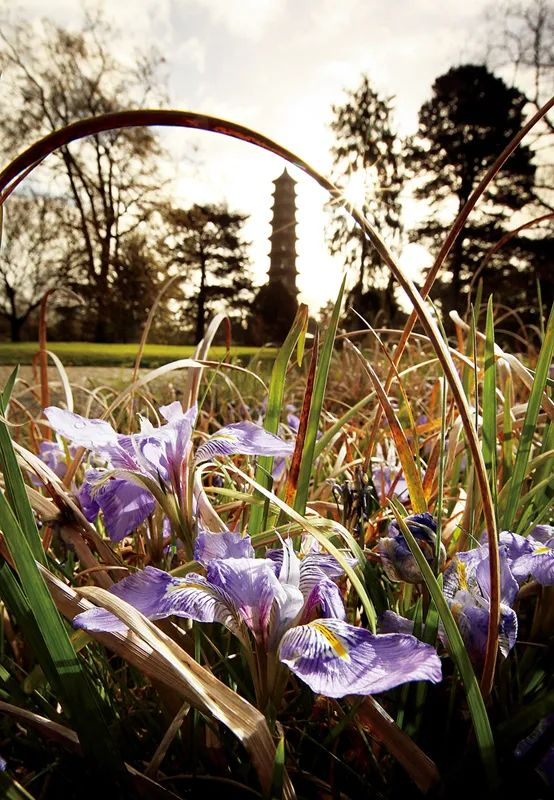
■ In the morning light, a Chinese pagoda with a long history can be vaguely seen in a corner of Kew Gardens. Built in 1762, this brick pagoda has stood for hundreds of years, witnessing the glory and splendor of this Royal Botanic Gardens despite all the vicissitudes of life.

Wonderful layout presentation
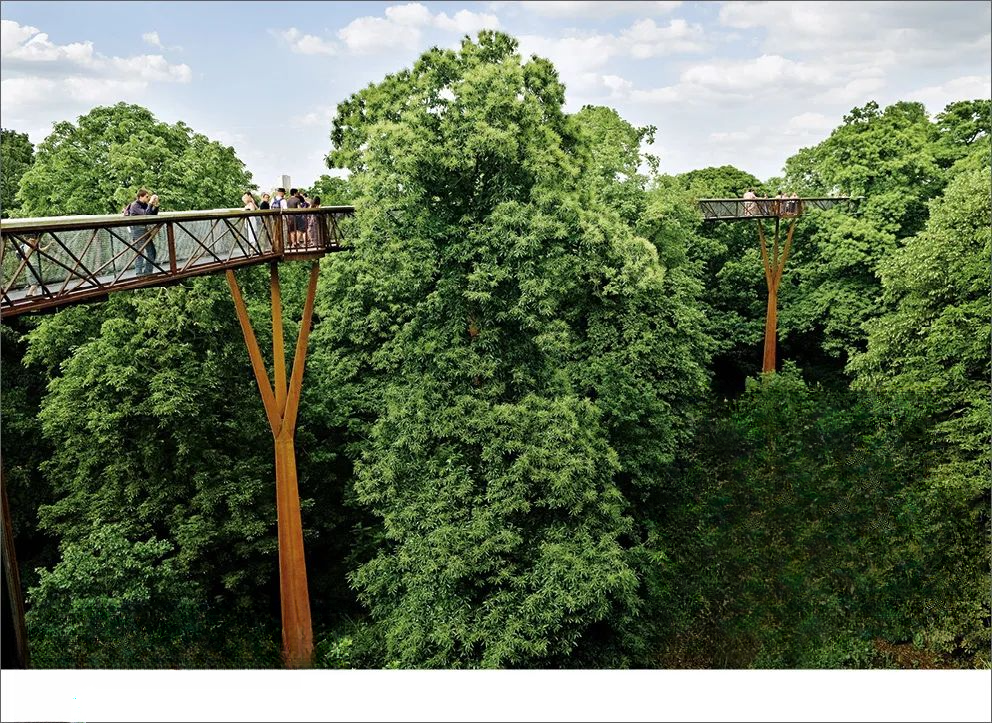
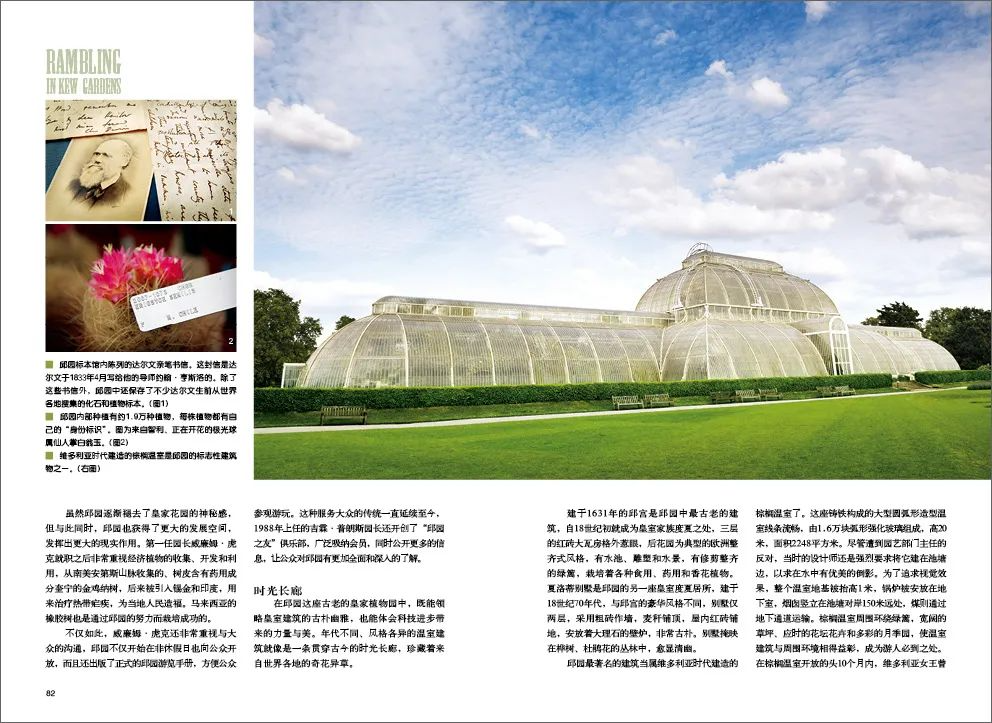
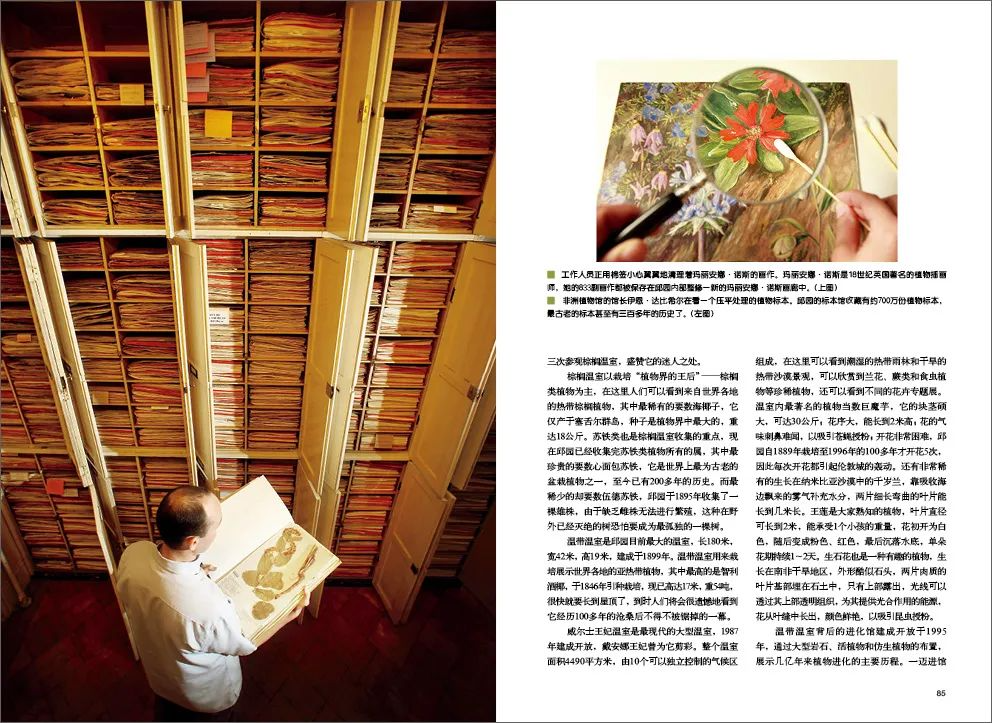
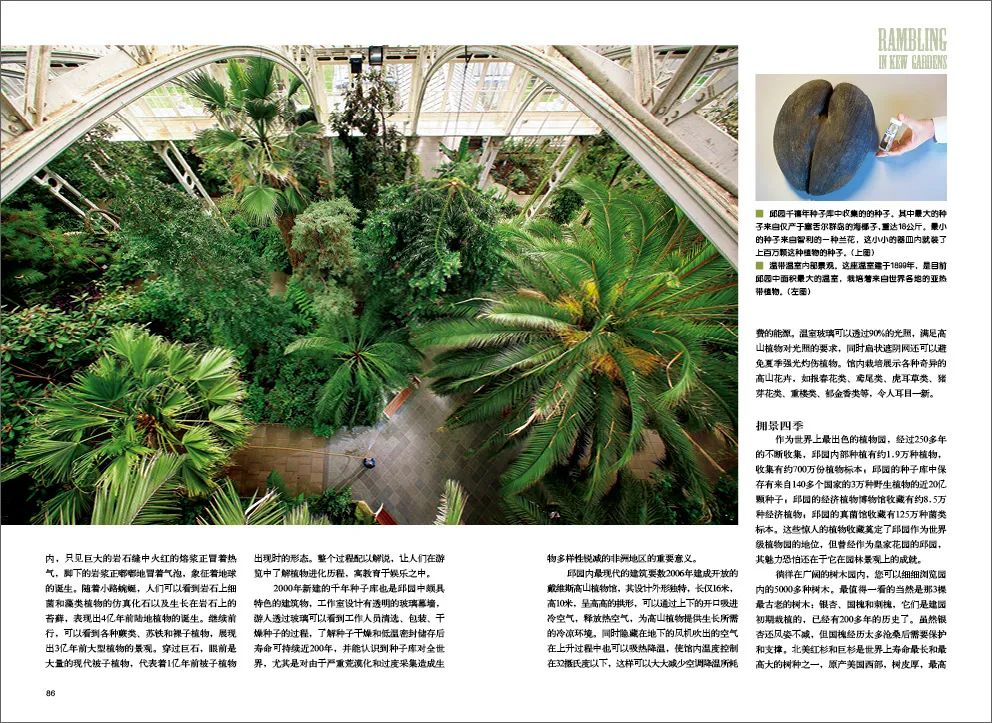
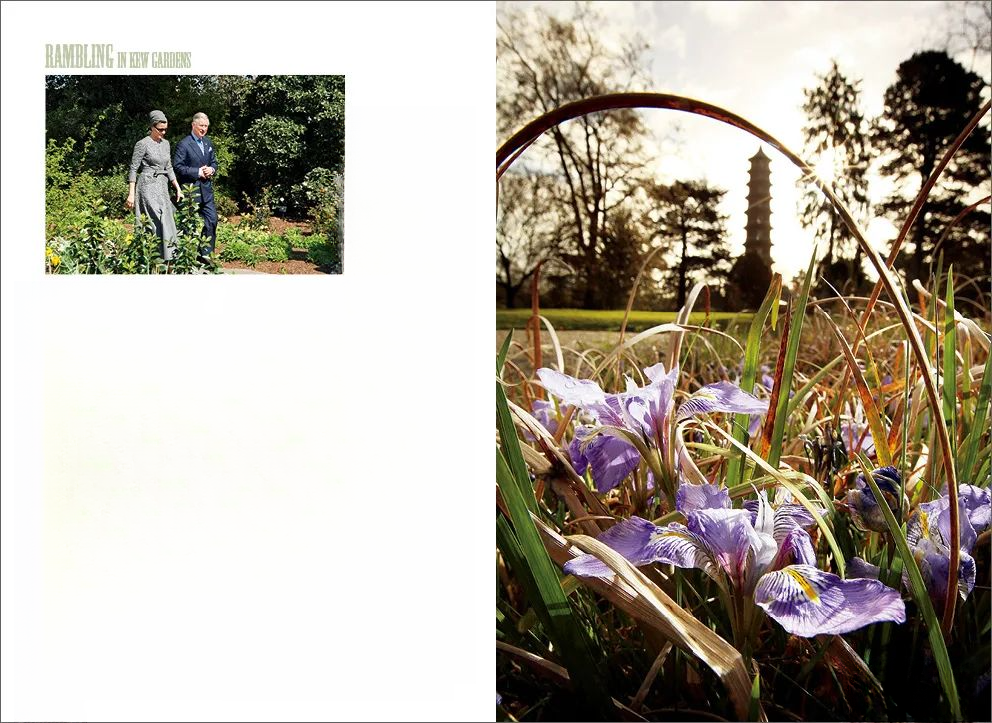

This article was originally published in the June 2012 issue of Civilization magazine.